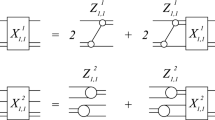Summary
The6Li nucleus is considered as composed of an alphaparticle, a proton and a neutron. With this construction the6Li nucleus is studied as a three-body problem. The Faddeev equations are given, by taking separable potentials for the interaction between the alpha, the proton and the neutron particles in pairs. The nucleon-nucleon potential is taken as a central term of the Yamaguchi type and also including a tensor force. To investigate the short-range correlations in this three-body system, the nucleon-nucleon potential is taken to include a repulsive soft-core part in addition to the attractive part considered. The nucleon-alpha potential is taken as central and spin-orbit terms which fit the corresponding experimental nucleon-alpha phase shifts. The effect of Coulomb forces between the proton and the alpha-particle is taken into account. By solving the coupled Faddeev equations numerically, the binding energies for the ground and excited states of6Li are calculated. Inclusion of repulsive-core effects is found to change the results by 19%.
Riassunto
Il nucleo6Li è ritenuto composto di una particella α, un protone ed un neutrone. Con questa struttura il nucleo di6Li è studiato come un problema di tre corpi. Si danno le equazioni di Faddeev prendendo potenziali separabili per l’interazione tra la particella α il neutrone e il protone a coppie. Il potenziale d’interazione nucleone-nucleone è dato da un termine centrale del tipo di Yamaguchi e comprendente anche una forza tensoriale. Per analizzare le correlazioni a breve raggio in questo sistema a tre corpi, si considera un potenziale nucleone-nucleone che comprenda una parte repulsiva del nocciolo molle accanto alla parte attrattiva considerata. Il potenziale nucleone-particella α è dato da termini centrali e spin-orbita che approssimano i corrispondenti spostamenti di fase sperimentali nucleone-α. Si prende in considerazione l’effetto delle forze di Coulomb tra protone e particella α. Risolvendo numericamente le equazioni di Faddeev accoppiate, si calcolano le energie di legame per gli stati fondamentale ed eccitato del6Li. Si trova che se si considerano gli effetti del nocciolo repulsivo i risultati cambiano del 19%.
Similar content being viewed by others
References
P. H. Wackman andN. Austern:Nucl. Phys.,30, 529 (1962).
B. Barsella, L. Lovitch andS. Rosati:Nucl. Phys.,117 A, 638 (1968).
A. Osman:Phys. Lett.,34 B, 478 (1971).
A. Osman:Particles and Nuclei,3, 28 (1972).
L. D. Faddeev:Žurn. Ėksp. Teor. Fiz.,39, 1459 (1960) (English translation:Sov. Phys. JETP,12, 1014 (1961));Dokl. Akad. Nauk SSSR,138, 565 (1961) (English translation:Sov. Phys. Dokl.,6, 384 (1961));Dokl. Akad. Nauk SSSR,145, 301 (1962) (English translation:Sov. Phys. Dokl.,7, 600 (1963)).
C. Lovelace:Phys. Rev.,135, B 1225 (1964).
A. Osman:Lett. Nuovo Cimento,4, 817 (1970).
A. Osman:Int. Journ. Theor. Phys.,16, 81 (1977).
P. E. Shanley:Phys. Rev.,187, 1328 (1969).
D. S. Chuu, C. S. Han andD. L. Lin:Phys. Rev. C,7, 1329 (1973).
A. Ghovanlou andD. R. Lehman:Phys. Rev. C,9, 1730 (1974).
J. V. Noble:Phys. Lett.,55 B, 433 (1975).
M. Rai, D. R. Lehman andA. Ghovanlou:Phys. Lett.,59 B, 327 (1975).
B. Charnomordic, C. Fayard andG. H. Lamot:Phys. Rev. C,15, 864 (1977).
A. N. Mitra, V. S. Bhasin andB. S. Bhakar:Nucl. Phys.,38, 316 (1962).
Y. Yamaguchi:Phys. Rev.,95, 1628, 1635 (1954).
F. Tabakin:Ann. of Phys.,30, 51 (1964).
A. Osman:Nuovo Cimento,41 A, 199 (1977).
A. Osman:Nucl. Phys.,153 A, 524 (1970).
M. H. McGregor, R. A. Arndt andR. M. Wright:Phys. Rev.,182, 1714 (1969).
G. R. Satchler, L. W. Owen, A. J. Elwyn, G. L. Morgan andR. L. Walter:Nucl. Phys.,112 A, 1 (1968).
A. Osman:Phys. Rev. C,4, 302 (1971).
L. D. Faddeev:Mathematical Aspects of the Three-Body Problems in the Quantum Scattering Theory, translated from Russian by the program for Scientific Translations, Jerusalem (New York, N. Y., 1965).
T. Lauritsen andF. Ajzenberg-Selove:Nucl. Phys.,78, 1 (1966).
Author information
Authors and Affiliations
Additional information
Traduzione a cura della Redazione.
Rights and permissions
About this article
Cite this article
Osman, A. Faddeev equations for the6Li nucleus. Nuov Cim A 48, 121–132 (1978). https://doi.org/10.1007/BF02799670
Received:
Published:
Issue Date:
DOI: https://doi.org/10.1007/BF02799670



